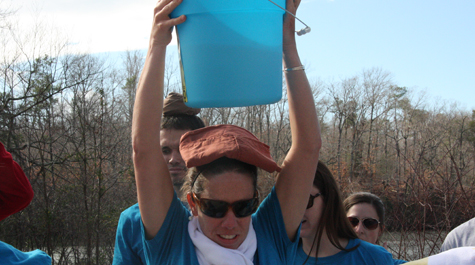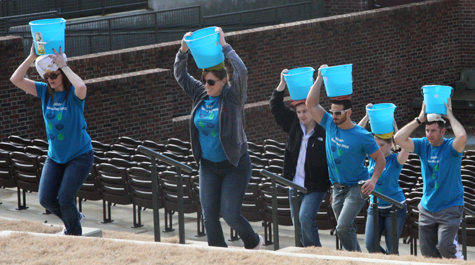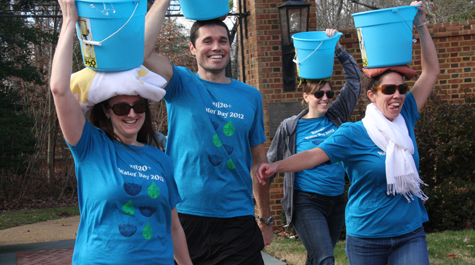Global water crisis: A social, business and economic issue
Every day, the average American turns on the tap and uses roughly 175 gallons of water.
In developing countries, women trek for miles carrying five-gallon buckets filled to the brim with water from rivers. That water is used in the household for both business and family needs, including cooking and drinking.
{{youtube:medium:left|7UAfR1K_WDA}}
On Friday, Jan. 27, more than 40 students with William & Mary’s Mason School of Business MBA Program participated in a Water Walk across campus to raise awareness of the drastic water disparities between the United States and developing countries. Students filled their blue buckets with a gallon-and-a-half of water, weighing roughly 13 pounds, and headed from Lake Matoaka Amphitheater toward the main part of campus.
The entire route measured a little more than a mile. Nuru International, a Kenya-based humanitarian organization assisting developing countries in need of water accessibility and sanitation improvement, helped to sponsor the event.
“I do hope that people experience a little bit of discomfort and a little bit of pain so they can get a small-scale version of what women go through,” said Renee del Castillo, a first-year student who organized the event. It’s common, she said, for many women to carry the buckets of water on their heads in extreme temperatures, and without shoes and proper clothing.
Deborah Hewitt, assistant dean for MBA Programs, said the global water crisis isn’t just a social issue. “It’s really a business issue; it’s an economic issue.
Almost every industry out there, from pharmaceuticals to steel, uses water in their production process – and lots of it,” she said.
For example, some companies use water as an input to cool their pipes and machinery, said Hewitt. Clean water is needed because too much sediment or mineral content can block the piping, causing damage and ultimately reducing the quality of the product. The used water must then be discharged into a stream or lake, continued Hewitt, and cleaned before being released back into the environment.
Not cleaning the water before releasing it can be devastating for the environment, she noted, killing rivers and lakes.
This year’s theme for the MBA Program is the world’s water crisis. Students are learning about the water shortage, issues of availability, accessibility and sanitation, and how they as business leaders can understand the issues to help make social changes. As part of the curricula, students are working on developing profitable business models for the provision of certain simple water-oriented technologies to drought-stricken areas of the world.
Water – and the lack of it – causes enormous agricultural challenges for poverty-stricken farmers in developing countries.
“Rural farmers are really limited in their production capabilities because they’re only working with a certain amount of water,” said del Castillo. “So they’re having to cut it in different ways, and take away from the food they cook, or the water they drink, so they can use it to support themselves with some sort of livelihood.”
The Water Walk is part of the Business School’s emphasis on social entrepreneurship and empowering students to use what they are learning to make a difference and create sustainable business models.
“We have a responsibility to ourselves – and the rest of the world – to take what we have learned here at William & Mary and use the practices to better the lives of others,” said del Castillo. “It’s not just going [to William & Mary] and getting a job, and viewing things like this as a check box for community service.
It needs to be a part of our lives.”


















